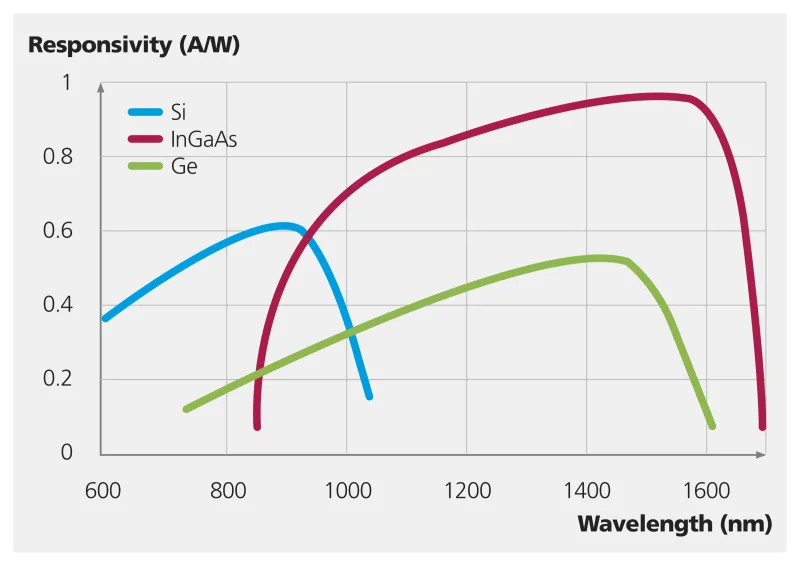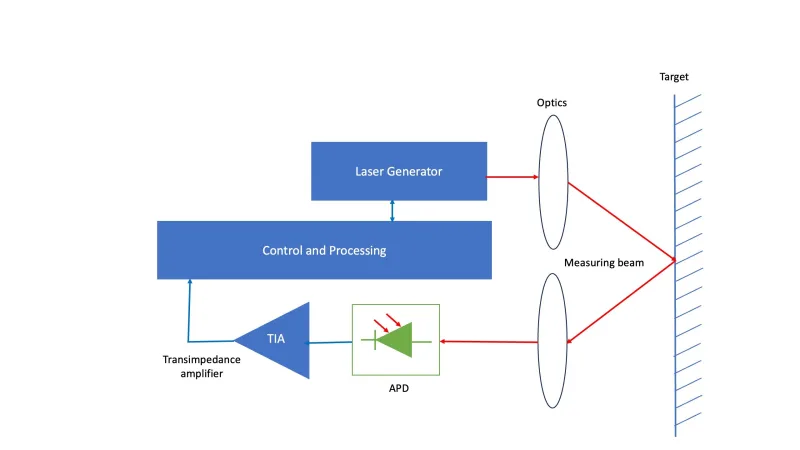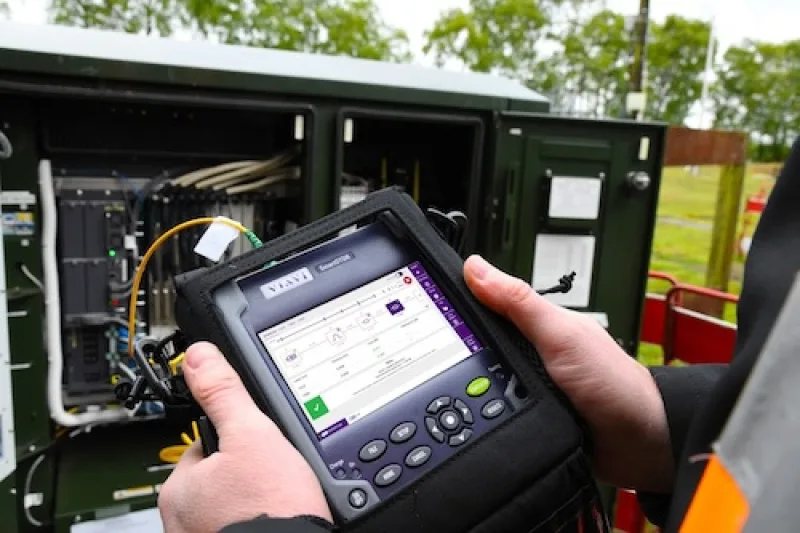A Guide to the Growing Applications for Infrared Time-of-Flight Sensing Technologies
Whether employing low-frequency acoustics, infrared, or anything in between, time-of-flight (ToF) systems are used for distance measurement, flow measurement, and imaging in a growing range of applications. This article introduces the basics of ToF systems. Then it explores the applications for infrared sensors, including laser range finders, optical test equipment, process control and automation, and intelligent transportation systems.
What ToF Systems Do
Time-of-flight (ToF) systems, which have long been used in industrial metrology and military ranging, are rapidly transitioning into mainstream applications. Whether the medium is a low-frequency acoustic wave or a high-frequency infrared pulse, ToF systems calculate distance by measuring how long a signal takes to reach an object and bounce back. With the convergence of low-cost optoelectronics, fast signal processing, and compact form factors, these systems are becoming indispensable in everything from factory automation to augmented reality.
Among the various ToF modalities, infrared-based systems offer a compelling balance of range, precision, power consumption, and component cost. As a result, they are finding their way into smartphones, smart buildings, autonomous vehicles, and beyond.
The Physics Behind ToF
ToF technology hinges on the relationship between time, velocity, and distance. By recording the round-trip time of a signal and knowing the propagation speed in the medium, 343 m/s for sound in air, ~300,000,000 m/s for light in vacuum, a system can determine the distance to a reflecting object:

The division by two accounts for the signal’s travel to the object and back. This principle is elegantly simple, but its real-world implementation is complicated by timing resolution, signal dispersion, ambient noise, and surface reflectivity.
Light-based ToF systems, which include those using infrared (IR) light, demand timing resolutions in the nanosecond or even picosecond range to resolve fine distances. For example, to measure a distance with 1 cm precision using a direct ToF method, the system must resolve time intervals of about 67 picoseconds. This places a high burden on detector and clock design.
Infrared ToF: Advantages and Working Principles
The near-infrared (NIR) portion of the electromagnetic spectrum is typically defined as between 750 nm and 2,500 nm. Many commercial IR ToF systems use wavelengths around 850 nm or 905 nm. However, 1550 nm systems are gaining popularity in high-performance applications. One key distinction lies in eye safety. Light at 905 nm can penetrate deeply into the retina, which limits the maximum safe power output under IEC laser safety regulations. This constrains the effective range of 905 nm systems. In contrast, 1550 nm light is absorbed by the eye’s cornea and lens, making it far safer for high-power applications. This allows laser generators to emit significantly more power without exceeding safety limits, greatly extending the usable range of systems.
1550 nm systems use InGaAs avalanche photodiodes (APDs) or, in a few niche applications, Ge (germanium) photodiodes as sensors. These systems are suited to rangefinders, fibreoptic and free-space optical communications and test, autonomous vehicles and ADAS, industrial surveying, and aerospace. While 905 nm dominates in areas like smartphones, AR/VR, and some robotics, 1550 nm is today carving out niches where long-range and high safety margins are paramount. Those niches are now growing, not least due to significant recent improvements in APD technology that have seen a 12X boost in device sensitivity along with other performance enhancements.

Infrared ToF systems, regardless of wavelength, consist of an IR emitter, such as a vertical-cavity surface-emitting laser (VCSEL) or LED, paired with a photodetector capable of resolving nanosecond-scale pulses. Depending on the architecture, they operate using either direct ToF (time-domain) or indirect ToF (phase-domain) principles, each with trade-offs in complexity, speed, and accuracy. In general, direct ToF is more precise and is less susceptible to multi-path interference, but indirect systems can offer higher resolution with sophisticated processing.
Application Deep Dive
Laser Range Finders and Precision Measurement
Laser range finders (LRFs) are perhaps the most straightforward application of IR ToF. These devices emit a pulsed or modulated IR beam and calculate the distance based on the time or phase of the returned signal. Modern LRFs can achieve accuracies within a few millimetres. In some military-grade models, that accuracy can be maintained over several kilometres. Phlux has developed an ultra-low noise preamplifier circuit from discrete components to enable best-in-class Noise Equivalent Power (NEP) performance of < 30 fW/√Hz for demanding rangefinder and LiDAR applications with up to 75 MHz bandwidth using the Aura 200 µm APD. This design is well-suited to defence applications.

Beyond defence and industrial applications, handheld LRFs are also widely used in construction and sports, replacing traditional tape measures and providing real-time data for golfers or archers.
Optical Fibre Test Equipment
Infrared ToF technology is the basis for Optical Time Domain Reflectometers (OTDRs), which measure fibre optic cable characteristics by emitting short infrared laser pulses and analysing backscattered/reflected signals. The distance to events like splices or breaks is calculated using the formula presented earlier, but with an adjustment to account for the refractive index of the fibre.

Smart Infrastructure and Intelligent Transportation Systems
Cities are becoming smarter, and ToF sensors are a key enabler. Mounted above roadways, these sensors count and classify vehicles, monitor pedestrian traffic, and inform adaptive traffic light systems. Because ToF sensors provide depth information, they can distinguish between a car, a bike, and a pedestrian—something that 2D cameras alone often struggle with.
ToF sensors also support adaptive lighting systems in streets and tunnels, turning lights on or off based on real-time traffic flow. In rail and air transit, they assist in platform safety monitoring, people counting, and obstacle detection.
In automotive design, IR ToF is being adopted inside and outside the vehicle. Internally, sensors monitor driver alertness and cabin occupancy. Externally, they support parking assistance and low-speed obstacle avoidance. While long-range LiDARs often take centre stage in autonomous and assisted driving, short-range ToF is often more practical for tasks like curb detection and tight manoeuvring.
Industrial Automation
Infrared ToF systems can be a cornerstone of process control in some automated factories. Whether mounted on robotic arms or embedded in conveyor systems, they enable precise positioning, detect object presence, and measure dimensions without contact. In robotics, they serve as the primary sensing modality for mapping and obstacle detection, especially when integrated with inertial and visual sensors in SLAM (simultaneous localisation and mapping) algorithms.
In semiconductor manufacturing and photonics, ToF sensors support optical metrology by creating 3D surface profiles and checking component alignments. Unlike structured light systems or mechanical probes, ToF can operate in harsh environments and measure reflective, curved, or uneven surfaces with minimal preprocessing.
Consumer Electronics and Emerging Technologies
One of the most visible adoptions of IR ToF is in smartphones. Apple's Face ID uses a structured light system, but many Android devices rely on ToF depth cameras for facial recognition, AR gaming, and enhanced photography. By measuring the depth of scene elements, the camera can produce more realistic bokeh effects and enable spatially aware apps.
In augmented and virtual reality, ToF sensors are critical for room mapping, gesture recognition, and object tracking. Their fast update rates and compact form factors make them ideal companions for wearable headsets, where traditional cameras would add latency or power overhead.
Challenges and Considerations
Despite their versatility, IR ToF systems face several technical challenges. Sunlight, which includes strong IR components, can saturate sensors and mask return signals, reducing accuracy or effective range. Multi-path reflections—where light bounces off multiple surfaces before returning—can create artifacts or ghost readings in 3D reconstructions.
Material properties also matter. Dark or absorptive surfaces return weaker signals, as do transparent materials like glass. Highly reflective surfaces can confuse detectors by creating multiple overlapping signal paths.
Engineers address these issues through hardware and software strategies. Optical bandpass filters and fast shutters reduce ambient light effects. Signal processing techniques like histogram analysis and machine learning can help distinguish valid returns from noise. Some systems combine ToF with stereo vision or structured light to overcome the weaknesses of any one modality.
The Road Ahead
As sensor technology continues to advance, ToF systems are becoming more accurate, more power-efficient, and easier to integrate. Developments in SPAD (single-photon avalanche diode) arrays, which can detect single photons at nanosecond resolution, are pushing the boundaries of sensitivity and resolution. Chipmakers are also integrating ToF functionality directly into image sensors, reducing cost and size.
Looking ahead, we can expect broader adoption in healthcare (for patient monitoring and gesture-based interfaces), agriculture (for yield monitoring and crop scanning), and retail (for shelf tracking and customer analytics). With AI integration, ToF systems will increasingly contribute to higher-level decision-making processes, converting raw depth data into meaningful actions.
Whether embedded in your phone, your car, or the smart infrastructure around you, Time-of-Flight systems, especially those leveraging infrared, are poised to become a foundational layer in the growing ecosystem of spatially aware technologies.
NOTE: This article was first published in Electronic Specifier on 25th August 2025.